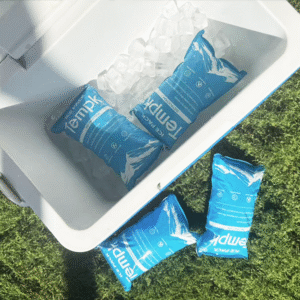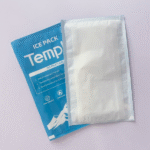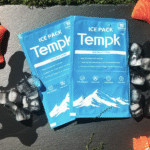Cómo utilizar hielo seco para refrigeradores y garantizar un envío seguro: Una guía completa
El hielo seco es una potente solución de refrigeración que desempeña un papel crucial en la logística de la cadena de frío.. Garantiza el transporte seguro de mercancías perecederas., desde alimentos congelados hasta productos farmacéuticos. Comprender cómo manejar el hielo seco de manera efectiva es esencial para cualquiera que envíe artículos sensibles a la temperatura.. Esta guía lo guiará a través de las mejores prácticas para usar hielo seco en hieleras., Asegurando seguro, envío eficiente, y mantener la integridad del producto.

-
Qué es el hielo seco y cómo funciona en las neveras portátiles.
-
Las mejores prácticas para utilizar hielo seco en neveras portátiles.
-
Cómo enviar productos de forma segura con hielo seco.
-
Errores comunes que se deben evitar al utilizar hielo seco para envíos.
¿Qué es el hielo seco y cómo funciona para las neveras portátiles??
El hielo seco es la forma sólida de dióxido de carbono (CO2), que se sublima directamente de sólido a gas a -78,5°C (-109.3°F). Este proceso de sublimación lo convierte en un agente refrescante ideal., ya que mantiene un ambiente muy frío sin los residuos de agua que deja el hielo normal..
Control de llave:
-
El hielo seco absorbe el calor de su entorno., mantener un ambiente muy frío.
-
Es perfecto para enviar productos sensibles a la temperatura, como alimentos congelados., vacunas, y muestras biológicas.
-
El hielo seco puede mantener los artículos congelados o a bajas temperaturas durante períodos prolongados., haciéndolo indispensable para el envío de larga distancia.
Por qué utilizar Hielo seco para enfriadores en envío?
Se prefiere el hielo seco al hielo normal por varias razones:
1. Mayor tiempo de enfriamiento:
El hielo seco mantiene temperaturas más bajas durante mucho más tiempo, a menudo hasta 24-48 horas, dependiendo de la cantidad utilizada y del aislamiento del refrigerador. A diferencia del hielo del agua, que se derrite y pierde poder de enfriamiento rápidamente, El hielo seco continúa absorbiendo calor sin convertirse en líquido..
2. Sin residuos de agua:
El hielo regular se derrite en el agua, comprometer potencialmente el embalaje y hacer que los artículos se empapen. El hielo seco se sublima hasta convertirse en gas., sin dejar agua atrás. Esto lo hace particularmente útil para enviar alimentos., productos farmaceuticos, y otros bienes sensibles.
3. Eficiencia para envíos de larga distancia:
Para envíos internacionales o al día siguiente, El hielo seco garantiza que sus productos permanezcan dentro del rango de temperatura requerido., eliminando el riesgo de descongelación o deterioro durante el tránsito.
Las mejores prácticas para usar hielo seco en enfriadores
1. Asegurar la ventilación adecuada:
Al usar hielo seco, Es fundamental ventilar la hielera o la caja de envío.. El hielo seco se sublima en gas dióxido de carbono, que puede desplazar el oxígeno en un espacio cerrado, planteando importantes riesgos para la salud, incluyendo asfixia. Asegúrese siempre de que su refrigerador tenga rejillas de ventilación para liberar el gas de forma segura..
2. Elija el embalaje correcto:
Seleccione cajas o refrigeradores aislados diseñados específicamente para soportar el frío extremo del hielo seco.. Para proteger aún más tus artículos, considere el doble boxeo, especialmente para envíos de larga distancia, para minimizar las fluctuaciones de temperatura.
3. Utilice cantidades correctas:
La cantidad de hielo seco necesaria depende de la duración del envío y de las mercancías que se envían.. Como regla general, usar alrededor 5-10 libras de hielo seco para la mayoría de los envíos. Para tiempos de tránsito más largos, aumentar la cantidad en consecuencia.
Consideraciones clave de seguridad para el envío con hielo seco
1. Manipulación con cuidado:
El hielo seco puede provocar quemaduras graves, así que siempre use guantes aislantes cuando lo manipule. El contacto directo con la piel puede provocar congelación..
2. Reglamento de Transporte:
El envío con hielo seco está regulado por ley. Asegúrese de conocer los límites de peso (generalmente 5.5 libras por paquete), así como la necesidad de un etiquetado adecuado. Los paquetes que contienen hielo seco deben estar claramente marcados con las etiquetas de materiales peligrosos apropiadas para garantizar la seguridad..
3. Etiquetado y Documentación:
El etiquetado correcto es esencial para los envíos de hielo seco. Asegúrese de que su paquete incluya etiquetas como “Hielo seco” y el peso del hielo seco utilizado. Esto garantiza que los manipuladores sean conscientes de los riesgos potenciales y puedan tomar las precauciones adecuadas..
Cómo garantizar un envío seguro con hielo seco
Seleccionar el enfriador adecuado
Elegir el refrigerador correcto es crucial para mantener la eficiencia del hielo seco durante el envío.:
-
Enfriadores de espuma de poliestireno: Ideal para envíos de corta distancia, Estos refrigeradores proporcionan un aislamiento decente, pero pueden no ser suficientes para envíos de larga distancia..
-
Cajas con Aislamiento Térmico: Estas cajas están diseñadas para envíos en cadena de frío., proporcionando mayores niveles de aislamiento y retención de frío extendida. Son perfectos para envíos de larga distancia..
-
Preenfriamiento de su refrigerador: Antes de agregar hielo seco, Es beneficioso enfriar el recipiente usando bolsas de gel o congelándolo durante la noche.. Este paso adicional ayuda a mantener una temperatura fría constante durante períodos más prolongados..
La ventilación es clave
La ventilación adecuada es fundamental cuando se utiliza hielo seco. Mientras el hielo seco se sublima, se convierte en gas dióxido de carbono. Sin una ventilación adecuada, La presión dentro del refrigerador puede aumentar., conduciendo a situaciones peligrosas, incluida la posibilidad de que el contenedor estalle. Asegúrese de que la hielera o caja tenga rejillas de ventilación para permitir que escape el gas..
Calcular la cantidad de hielo seco
La cantidad de hielo seco necesaria varía según el tamaño de la hielera y la duración del envío.. Una regla general es:
-
Para envíos en 24 horas: Utilice aproximadamente 5 libras de hielo seco por cada 5-10 libras de productos perecederos.
-
Para envíos más largos: Agregar 1-2 libras de hielo seco por cada adicional 24 horas de transito.
Utilice los materiales de embalaje correctos
Al empacar hielo seco en hieleras, Utilizar los materiales adecuados para evitar percances.:
-
Bolsas de polietileno: Estas bolsas son ideales para contener el hielo seco y permitir que se sublime..
-
Embalaje aislado: Asegúrese de que sus materiales de embalaje, como espuma o cajas de cartón de doble pared, estén diseñados para contener el hielo seco y reducir su escape., ayudando a mantener el frío por más tiempo.
Tipo de embalaje y duración
| Tipo de embalaje | Tipo de aislamiento | Ideal para | Duración esperada |
|---|---|---|---|
| Enfriador de espuma de poliestireno | Poliestireno expandido | corta distancia | 12-24 horas |
| Caja con aislamiento térmico | Espuma o sellado al vacío | De larga distancia | 24-72 horas |
| Bolsa de polietileno | plástico flexible | Contacto directo | 12-48 horas |
Evite errores comunes al realizar envíos con hielo seco
1. No etiquetar correctamente:
Asegúrese siempre de que su paquete tenga el etiquetado necesario, incluido “Hielo seco” y el peso del hielo seco utilizado. Un etiquetado incorrecto puede provocar retrasos o una mala manipulación.
2. Exceder los límites de envío:
Diferentes transportistas tienen diferentes reglas con respecto a los límites de peso del hielo seco, típicamente 5.5 libras. Siempre verifique las regulaciones de su transportista específico antes de realizar el envío..
3. Usar aislamiento incorrecto:
El uso de un aislamiento de mala calidad o un contenedor sin ventilación puede hacer que el hielo seco se sublime antes de que llegue su envío.. Esto hará que los productos lleguen calientes y potencialmente estropeados..
2025 Tendencias en el envío de hielo seco para refrigeradores
La industria logística de la cadena de frío continúa evolucionando, con el objetivo de mejorar la seguridad, eficiencia, y sostenibilidad. Están surgiendo nuevas tendencias que prometen revolucionar el uso del hielo seco en el transporte marítimo.:
Últimos desarrollos en envío de hielo seco
-
Embalaje inteligente: Las tecnologías emergentes de envasado inteligente ahora permiten el monitoreo en tiempo real de la temperatura y la humedad., Permitir a las empresas realizar un seguimiento de los envíos de forma más eficaz..
-
Alternativas sostenibles: A medida que aumenta la demanda de soluciones ecológicas, Hay un interés creciente en alternativas sostenibles al hielo seco., como paquetes de refrigeración híbridos.
-
Cambios regulatorios: Las regulaciones de envío se están endureciendo, y más países están adoptando leyes ambientales y de seguridad estrictas para el transporte de hielo seco.
Perspectivas del consumidor y del mercado
Con el auge del comercio electrónico y la creciente demanda de servicios rápidos, envío confiable, El uso de hielo seco para refrigeración y envío sigue siendo esencial.. A medida que las empresas priorizan rápidamente, entrega confiable, El hielo seco sigue siendo uno de los métodos más fiables para conservar artículos sensibles a la temperatura..
Preguntas frecuentes (Preguntas frecuentes)
Q1: ¿Cuál es la cantidad máxima de hielo seco que puedo enviar??
El límite general para el hielo seco es 5.5 libras por paquete, pero varía según el transportista. Consulta siempre las normativas específicas de la empresa de transporte que estés utilizando..
Q2: ¿Cómo estoy dispuesto a hielo seco??
Deje que el hielo seco se sublime en un área bien ventilada.. Nunca lo deseche en un espacio cerrado., ya que el gas puede ser peligroso.
Conclusión y recomendaciones
Utilizar con éxito hielo seco para neveras portátiles y garantizar un envío seguro., Es vital seguir las mejores prácticas, como seleccionar el enfriador adecuado., utilizando un embalaje adecuado, y cumplir con las regulaciones de envío. Ventilación adecuada, etiquetado, y las precauciones de seguridad ayudarán a garantizar que su envío llegue en condiciones óptimas.
Próximos pasos para su negocio
-
Revise su proceso de envío: Asegúrese de que el hielo seco se integre eficazmente en sus procesos de envío.
-
Optimizar para la eficiencia: Implementar los últimos avances en logística de cadena de frío para mejorar la seguridad y reducir costos..
-
Asóciese con expertos: Trabaje con proveedores de logística que se especializan en cadena de frío y envío de hielo seco para garantizar los mejores resultados posibles..
Acerca de Tempk
Y tempk, Nos especializamos en brindar soluciones de cadena de frío adaptadas a sus necesidades de envío.. Con un enfoque en la calidad, seguridad, y sostenibilidad, Nuestros productos están diseñados para ayudarle a lograr una frescura y seguridad óptimas para sus productos sensibles a la temperatura..
Consulte con nosotros para obtener asesoramiento experto sobre el envío de hielo seco y la optimización de la logística de su cadena de frío..























